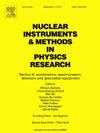iRPC Front End electronics cooling system in CMS
IF 1.5
3区 物理与天体物理
Q3 INSTRUMENTS & INSTRUMENTATION
Nuclear Instruments & Methods in Physics Research Section A-accelerators Spectrometers Detectors and Associated Equipment
Pub Date : 2025-04-15
DOI:10.1016/j.nima.2025.170490
引用次数: 0
Abstract
In view of the High-Luminosity upgrade of LHC, the CMS Muon spectrometer is undergoing a series of upgrade projects,in particular the addition of four new stations featuring improved Resistive Plate Chambers (iRPC), which will cover the pseudo-rapidity range from 1.8 to 2.4. A new Front-End Board (FEB) is designed to read iRPC signals with a very low threshold and a Time Digital Converter (TDC) embedded into a Cyclone V INTEL FPGA with a resolution of 30 ps and a sampling of 100 MHz. In contrast to the previous RPC boards, this one produces 21–22 W of heat in a confined space that needs to be carefully evacuated. A cheap and robust cooling system was designed on the basis of a copper plate and water cooling. This system was first simulated with a Computational Fluid Dynamics package, Ansys Fluent, and then optimized with thermal measurements. In this paper, the system and its prominent features are described. A quantitative comparison between the experimental measurements in the laboratory and the simulation is provided to demonstrate the robustness of this simple cooling system.
CMS中的iRPC前端电子冷却系统
鉴于LHC的高亮度升级,CMS μ子谱仪正在进行一系列升级项目,特别是增加了四个具有改进电阻板室(iRPC)的新站,其伪快度范围将从1.8到2.4。新的前端板(FEB)设计用于读取具有非常低阈值的iRPC信号和嵌入Cyclone V INTEL FPGA的时间数字转换器(TDC),分辨率为30 ps,采样为100 MHz。与之前的RPC板相比,这一个在需要小心疏散的密闭空间中产生21-22瓦的热量。在铜板和水冷却的基础上设计了一种廉价而坚固的冷却系统。该系统首先使用计算流体动力学软件包Ansys Fluent进行模拟,然后通过热测量进行优化。本文介绍了该系统及其主要特点。通过对实验结果和仿真结果的定量比较,证明了该简单冷却系统的鲁棒性。
本文章由计算机程序翻译,如有差异,请以英文原文为准。
求助全文
约1分钟内获得全文
求助全文
来源期刊
CiteScore
3.20
自引率
21.40%
发文量
787
审稿时长
1 months
期刊介绍:
Section A of Nuclear Instruments and Methods in Physics Research publishes papers on design, manufacturing and performance of scientific instruments with an emphasis on large scale facilities. This includes the development of particle accelerators, ion sources, beam transport systems and target arrangements as well as the use of secondary phenomena such as synchrotron radiation and free electron lasers. It also includes all types of instrumentation for the detection and spectrometry of radiations from high energy processes and nuclear decays, as well as instrumentation for experiments at nuclear reactors. Specialized electronics for nuclear and other types of spectrometry as well as computerization of measurements and control systems in this area also find their place in the A section.
Theoretical as well as experimental papers are accepted.

 求助内容:
求助内容: 应助结果提醒方式:
应助结果提醒方式:


